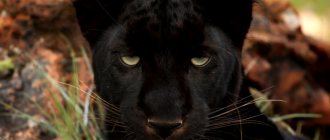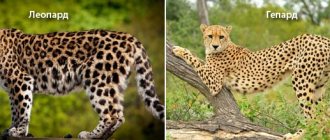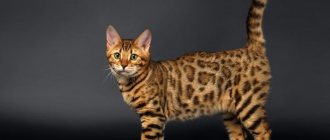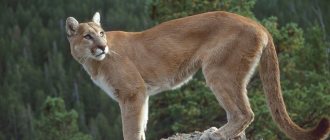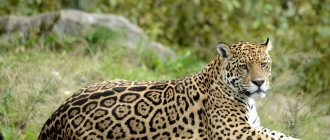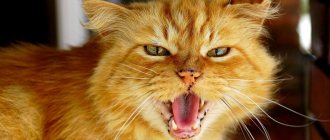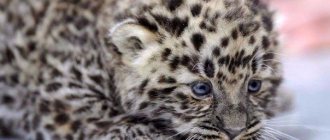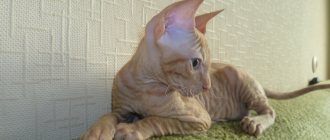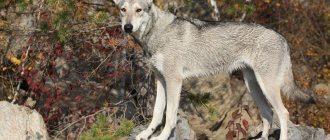Home » Interesting collections about animals
Nature surprises with the unusual colors of animals. Bright spots on the body help in hunting, camouflage, and attract individuals of the opposite sex. We bring to your attention 11 of the most spectacular and spotted representatives of the planet, which will take your breath away.
- 2 Hyena.
- 3 Snow leopard.
- 4 Leopard.
- 5 Ocelot.
- 6 Ladybug.
- 7 Skunk.
- 8 Octopus.
- 9 Dalmatian.
- 10 Lynx.
- 11 Bush cat.
Hyena.
Small predators live in Africa and prefer to be in a pack. They are dangerous not only for mammals, but also for travelers who may encounter a hyena during their trip.
Spots on the fur help in hunting; with their help, animals externally merge with the ground and stones. The color allows them to be invisible to the victim and wait for the right moment to attack. Predators are difficult to spot in nature when they move around. There are few spotted hyenas left on the planet; the species is listed in the Red Book.
Giraffe.
The giraffe's body is covered with small dark brown spots, which differ in shape, size and shade. The individual pattern of each individual resembles human fingerprints - in nature, there are no two giraffes with identical markings. The combination of patterns is passed on to the offspring from the mother.
Animals live in different areas of Africa and are attacked by predators. The pattern on the body helps giraffes to camouflage themselves in acacia bushes or near sun-bleached trees. Dark lines merge with the crown and bark; animals recognize relatives from their herd by spots and identify specific individuals.
Snow leopard.
Famous photographers who photograph wildlife willingly capture the predator because of its unusual color. He lives in the mountains of Central Asia and lives alone. It is difficult to meet a snow leopard in the wild, but those who wish can watch them in large zoos.
The bright spots that decorate the fur of wild cats help them hide among snow-covered rocks and stones. The color of the skin depends on the region where it lives and the time of year. In summer, the coat lightens, becomes almost white, and in winter it acquires a gray tint.
Population and species status
The total number of sika deer has decreased markedly over the past hundred years. The main reason is active hunting, although a number of other factors can be mentioned, such as:
- Disappearance of broad-leaved forests.
- The emergence of new human settlements in deer habitats.
- The appearance of a large number of wolves and dogs.
- Lack of food and the presence of infectious diseases.
The emergence of reindeer farms also had a negative impact on the number of such animals, since many animals died due to the wrong actions of their employees. Nowadays, any hunting of sika deer is prohibited everywhere. The animals are listed as endangered in the International Red Book.
NEPAL! Episode 2. The life of a barking sika deer (Axis axis)!!!
Leopard.
Dangerous and graceful predators are found alone in some areas of Africa and the forests of Asia. The spotted coloring covers the body from the top of the head to the tip of the tail and helps to hide from prying eyes. Leopards move slowly and carefully when stalking their future prey. Feral cats are difficult to replace among colorful shrubs, trees and rocks.
Spotted camouflage has a unique pattern, the intensity of which depends on the pigmentation characteristics. The black panther, which is a member of the leopard, also has dark spots. They do not differ, because they merge with the main color of the coat.
Sokoke
The ancestors of this cat are the forest cats of Kenya. Sokoke is a natural breed that has not been touched by human hands.
Despite its wild ancestors, the Sokoke cat is of medium size (weight - 3-5 kg). The head is wedge-shaped and elongated.
The ears are medium, wide at the base, and may have tufts. The eyes are slightly inclined to the base of the ears, surrounded by a dark rim. Eye color can be green, amber, yellow.
The Sokoke's coat is short, with little or no undercoat. It feels harsh to the touch.
Representatives of this breed are very playful, even hyperactive. They love children and show tolerance towards them. Sokoke are quite independent, but they will have a hard time being separated from their owner for a long time.
Ocelot.
The miniature predator has unusual spotted patterns on its body. Ocelots live in South and Central America and prefer to live alone. During the day they camouflage themselves under tree branches, and when the evening cools, they go out hunting.
Bright colors help wild cats pass unnoticed through thickets and attack prey. The spotted skin serves as a guide for the baby ocelots as they move through the terrain overgrown with bushes and tall grass.
Octopus.
Octopuses are found in all seas and oceans, except cold northern waters. They do not live in families or packs, but prefer loneliness. Shellfish can be found in shallow waters, but most are home to greater depths and coral reefs.
Octopuses change color depending on their location. The bright stripes on the body merge with the textured corals, which allows them to quietly grab prey or hide from ill-wishers.
Dalmatian.
Large white dogs with dark spots attract the attention of others. The rich colors do not immediately appear on Dalmatian puppies; within 1-2 weeks the baby remains completely white.
The lynx lives in rugged coniferous forests, which are an ideal habitat. The animal is famous for the beauty of its spotted skin and tufted ears. The color of the coat helps the wild cat to hunt in the dark. It merges with the surrounding nature, tree bark and massive roots.
The lynx changes its color depending on the time of year. The color of the coat is gray, ash-white and red. The spotted coloring helps the animal peacefully enjoy sleeping on tree branches and appear invisible.
What does it eat?
This type of deer eats only plant foods, of which there are about 400 species. In Primorye and East Asia, 70% of the diet consists of trees and shrubs. The sika deer uses as food:
- oak, namely acorns, buds, leaves, shoots;
- linden and Amur grapes;
- ash, Manchurian walnut;
- maple, elm and sedge.
The animal uses the bark of trees for food from the middle of winter, when large areas of the ground are covered with snow; they do not neglect the branches of alder, willow and bird cherry. They very rarely drink sea water.
Bush cat.
The miniature predator lives in the African savanna. The body of the bush cat is decorated with contrasting dark spots. The animal needs them for evening and night hunting, so that the prey does not have time to see it among the terrain. A wild cat watches its future prey for a long time, so that it can then attack it quickly and with lightning speed.
Nature took care of the living conditions of wild inhabitants, decorating their bodies with unusual patterns and markings. They help animals blend in with their environment, get food and recognize their packmates.
Source
Cat family
The cat family includes 37 species, including cheetahs, pumas, jaguars, leopards, lions, lynxes, tigers and domestic cats. Wild cats live in all regions except Australia and Antarctica. Predators live in different places, but most often in forests.
The fur is decorated with spots or stripes, only the puma, jaguarundi and lion are of a uniform color. Black or almost black fur is found in individuals of several species. The lynx has a short tail, but most cats have a long tail, about a third of their body length. The only cat with a mane is a male African lion. Cats have sharp claws that retract, with the exception of the cheetah. In most cats, the male is larger than the female.
It has short legs, a long head, and large upper canines that are proportionally longer than those of any other cat.
The solitary animal lives among bushes and forests. Mainly nocturnal, sometimes basking in the sun.
A muscular cat with a long body, large head and short legs. Size and appearance differ between the sexes.
Well adapted to harsh, snowy winters and many different biotopes. Male territories extend up to 1,000 km2.
The stripes of this subspecies are especially wide and spaced further apart than those of other tigers. This gives the fur a bright, impressive appearance.
This is a mammal with thick paws, strong fangs and jaws, and fur with a characteristic pattern and color. Males are larger than females.
A striking feature is the fur, the color due to the lack of the pigment pheomelanin, which Bengal tigers possess.
Life of a sika deer
Animals occupy individual territories. Single animals prefer to graze in areas of 100–200 hectares, a male with a harem needs 400 hectares, and a herd of more than 15 heads needs about 900 hectares. When the rutting season ends, adult males unite in small groups. The herd may contain young animals of different sexes that have not yet reached 3 years of age. The size of the herd increases by winter, especially if the year was good for harvest.
Males who have reached the age of 3–4 years take part in mating games; they can have a harem of up to 4 females. In nature reserves, a strong male can cover from 10 to 20 females. Fights between adult males are very rare. The female bears the offspring for 7.5 months, calving occurs at the beginning of June.
In the summer, sika deer feed both day and night, and are also active on clear days in winter. During unfavorable weather conditions, for example, during snowfalls, deer prefer to lie down in dense forests.
Provided there is no snow, an adult is capable of moving quite quickly and easily overcomes obstacles 1.7 meters high. Snow drifts slow down the movements of animals, make them move spasmodically and cause problems with finding food.
Sika deer can migrate seasonally. The lifespan of deer in the wild is no more than 15 years. Their lives are shortened by: infections, hunger, predators, poachers. In nature reserves and zoos, sika deer can live up to 21 years.
Other members of the cat family
Steppe cat
It slowly approaches and attacks, pouncing on the victim as soon as it is within reach (about a meter). Active at night and at dusk.
grass cat
Color varies from grayish yellow and yellowish white to brown, taupe, light gray and silver gray.
Andean cat
They do not live in captivity. All Andean mountain cats in zoos have died. Fewer than 2,500 specimens are thought to exist in the wild.
Geoffroy's cat
Gray or brown with black markings, 90 cm long, of which the tail is 40 cm. Breeds once a year, litters consist of 2-3 kittens.
Chilean cat
The base color of the coat ranges from gray and reddish to bright brown or dark brown, with small rounded black spots.
Long-tailed cat
Lives in forests, is nocturnal, feeds on birds, frogs and insects. Claws and paws allow you to move through trees and along branches.
Far Eastern forest cat
The coat is usually yellowish or reddish-brown above, white below, and heavily marked with dark spots and streaks.
Oncilla
Lives in mountainous, subtropical forests and semi-arid areas. The oncilla was hunted for its beautiful fur in the second half of the 20th century.
Ocylot
The short, smooth fur is decorated with elongated spots with black edges, they are arranged in the form of chains. The upperparts are light or yellowish-brown to gray.
Pampas cat (bell)
About 60 cm long, including a 30 cm tail. The longhaired fur is grayish with brown markings, which are fuzzy in some cats.
Ocicat
This breed does not have savages in its pedigree. Her ancestors are Siamese and Abyssinians, which were later crossed with American Shorthairs. The birthplace of the breed is the USA.
Externally, the animal resembles a wild ocelot, which is why the breed was given the name “Ocicat”.
The animal's fur is dotted with spots located on a plain base. The main background of the coat can be different - from blue to brown. The fur is short.
The Ocicat's head is medium in size, its muzzle is oblong. The ears are round and large. The eyes are expressive, almond-shaped. Their color can be any except blue.
By nature, Ocicats are extroverts. They are active, sociable, and love to have fun. They are able to find a common language with all family members, but they choose only one owner.
